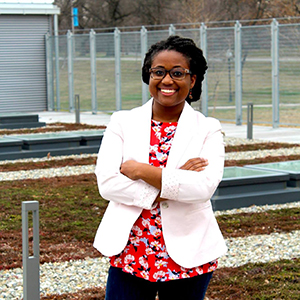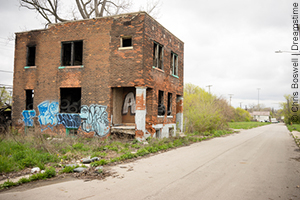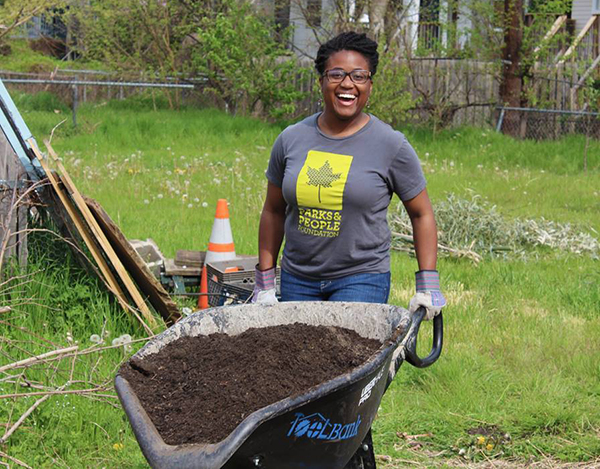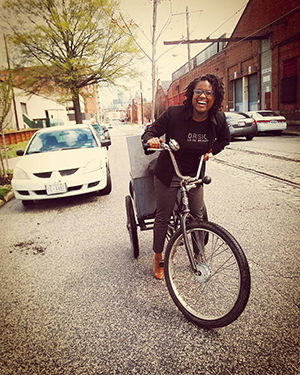My Path to Science and Activism
By Amy Nelson
By Tiffany Carey
“The person who loves their dream of community will destroy community, but the person
who loves those around them will create community.” Dietrich Bonhoeffer
 As a Detroit native, I was directly affected by City projects and plans, though not in the way the leaders of those initiatives intended. By and large, many City projects failed to live up to their lofty goals to increase community efficacy, connectivity, and resilience. The gaps between promises and realities of “urban renewal” efforts took a toll on community hope and resilience, and also on me. But they ended up propelling me into a life of science and activism.
As a Detroit native, I was directly affected by City projects and plans, though not in the way the leaders of those initiatives intended. By and large, many City projects failed to live up to their lofty goals to increase community efficacy, connectivity, and resilience. The gaps between promises and realities of “urban renewal” efforts took a toll on community hope and resilience, and also on me. But they ended up propelling me into a life of science and activism.
Given my love for the inner city, curiosity of urban vegetation, and dreams of bringing hope back into my community, I pursued a degree in Political Science with a minor in Environmental Science, with the goal of becoming an environmental lawyer. As a daughter of two African American parents—my father from inner city Chicago and my mother from Haiti—I was not accustomed to many paths other than law, medicine, business, and engineering. Those careers were exalted because of their prestige and perceived stable income. However, with a persistent yearning for change in my community, I was awarded an opportunity to pursue a four-year research project at the University of Michigan through the Undergraduate Research Opportunity Program. This program changed my life forever.
Raised in an urban environment, I was not accustomed to many formal natural landscapes outside of the local park or jungle gym. Hence, I started my apprenticeship with a very limited understanding about ecology and the scientific method to provide solutions to societal issues. It was not until my second semester of my undergraduate degree that I fully grasped the main subject I was truly passionate about—ecology. I quickly recognized the vital connection between community engagement and ecosystem resiliency. Working through the scientific method and creating a project that tackled a cross disciplinary topic, “Pollen and Public Health in Detroit,” I began to see the impact of how long term data on urban ecosystems’ structures can provide feedback between socio-ecological processes and city revitalization efforts. After extensive research with academic papers, literature, and hospital records, I created an experiment that crossed ecology and public health with a framework of environmental justice. I stationed my field work in Detroit to quantify the amount of allergenic pollen in several land uses including vacant lots, residential areas, and parks.
 During the beginning stages of my project, I engaged high school students to deploy homemade pollen collectors (based on Durham’s gravitational sampler) in different land use areas around their school (e.g., parks, vacant lots and residential spaces). The pollen collectors were subsequently gathered and we worked on each data set to identify and count the pollen grains present in each land type. This community-based approach linked my passion for and execution of science-based research with my strong belief that educating and involving the community is the avenue for real change. Concluding our first phase, we found that ragweed populations were highest in vacant lots, a common land cover type in Detroit. These results emphasized the importance of pollen production within the urban environment along with the management of allergic pollen producing plants on various spatial scales. Moreover, we discussed how socio-economic status and vacant lots have a strong correlation to the disproportionate amount of allergies and ragweed sensitization experienced by low income populations in Detroit.
During the beginning stages of my project, I engaged high school students to deploy homemade pollen collectors (based on Durham’s gravitational sampler) in different land use areas around their school (e.g., parks, vacant lots and residential spaces). The pollen collectors were subsequently gathered and we worked on each data set to identify and count the pollen grains present in each land type. This community-based approach linked my passion for and execution of science-based research with my strong belief that educating and involving the community is the avenue for real change. Concluding our first phase, we found that ragweed populations were highest in vacant lots, a common land cover type in Detroit. These results emphasized the importance of pollen production within the urban environment along with the management of allergic pollen producing plants on various spatial scales. Moreover, we discussed how socio-economic status and vacant lots have a strong correlation to the disproportionate amount of allergies and ragweed sensitization experienced by low income populations in Detroit.
Our findings from this research project made substantial contributions to the science community through two published papers. Our work was also recognized by local press, schools, and other organizations due to its societal impact through the lenses of: public health, environmental justice, and citizen science in an urban context. Despite many of these accolades, my most esteemed honor for this work was being awarded the Brower Youth Award in 2014. The Brower Youth Award was created through the Earth Island Institute in 2000 to highlight a small cohort of six young environmental leaders from across North America who are making a difference through environmental projects and activism. I, along with five other amazing individuals, met in California and participated in a variety of different activities and networking events to build on our strengths and equip us for our continued passion to trailblaze transformative environmental change in our communities. We ended our time sharing our stories with the Berkeley community and collaborating with other leaders that advised on best practices for next steps. To this day, I still give back through the projects and ideas that are shared amongst all of the Brower Youth Award cohorts. These amazing leaders have inspired me and continue to spark hope and courage within many other young people working through the challenges and successes that come with activism.
My undergraduate research and outreach efforts refined and molded my next steps in serving as a community organizer and greening strategist for the City of Baltimore. As the Growing Green Initiative community organizer, I consulted Baltimore residents, community groups and city agencies to determine the best possible re-use for vacant lots, especially after demolition and deconstruction. Some of these spaces were transformed to rain gardens, natural ‘playscapes,’ community gardens, urban farms, and other community-led greening uses. My work as a researcher in Detroit and a greening community organizer in Baltimore has deepened my belief that scientists should have a key role in engaging communities to improve urban ecological and social research, education, and outreach.

To facilitate transparent dialogue with the community, I worked with the intention to bring equitable solutions to the forefront of every greening project. Three key questions allowed me to build trust with people and establish a comprehensive approach to creating green spaces that truly served community needs.
What is your tie and connection with the space that you’re trying to revitalize?
What knowledge do you have about the space and the community surrounding?
What capacity have you built within your community to ensure “buy in”, engagement, and maintenance of your goal or other related projects?
Unlike many of my peers and colleagues in the ecology field, I was not initially fascinated and enamored with nature because of childhood experiences on camping trips, fishing expeditions, or hikes. I was drawn to the environment and its beauty because of my passion to make my community a better place. I struggled for many years with ongoing emotional fatigue and hopelessness, which led to low self-esteem and lack of self-worth. However, through the evolution of my citizen science project, I realized science was my voice and that my work in bringing change to my community offered a sense of pride and worth to my life and so many others.
I transitioned out of Baltimore in 2016 to pursue a position as a Science Education and Outreach Coordinator for the University of Michigan Applied Wildlife Ecology Lab. This position has allowed me to lead and facilitate all public engagement efforts in the lab including, but not limited to: designing and creating public engagement materials, organizing K-12 opportunities, and managing multi-stakeholder partnerships to broaden participation and bring awareness to wildlife in Michigan and beyond. Alongside my science and research skills, I would like to continue learning and improving my skills to create inclusive dialogue and solutions that provide a connection to ongoing maintenance, pride, and collective vision in communities who are directly impacted by land use changes and injustice. I am currently pursuing two Masters degrees (in Natural Resource Management and Urban Planning) to continue gaining the skills needed to design and consult on socio-ecological projects, while building sustainable spaces with community based approaches.
Community work is challenging, but the stories and life changing moments are worth the time and investment. Through this lens, my spark for research, community activism, and environmental justice has led me to pursue a career that aims to connect People of Color to nature. Additionally, I use my platform of self-love, healing, and passion to facilitate avenues to create equitable green spaces. My hope is that these spaces will reenergize the hope and power in people who have the right to enjoy the beauty of our natural landscapes.
*Editor’s note: Tiffany was recently featured in the blog 500 Women Scientists.
Raised in an urban environment, I was not accustomed to many formal natural landscapes outside of the local park or jungle gym. Hence, I started my apprenticeship with a very limited understanding about ecology and the scientific method to provide solutions to societal issues. It was not until my second semester of my undergraduate degree that I fully grasped the main subject I was truly passionate about—ecology. I quickly recognized the vital connection between community engagement and ecosystem resiliency. Working through the scientific method and creating a project that tackled a cross disciplinary topic, “Pollen and Public Health in Detroit,” I began to see the impact of how long term data on urban ecosystems’ structures can provide feedback between socio-ecological processes and city revitalization efforts. After extensive research with academic papers, literature, and hospital records, I created an experiment that crossed ecology and public health with a framework of environmental justice. I stationed my field work in Detroit to quantify the amount of allergenic pollen in several land uses including vacant lots, residential areas, and parks.
During the beginning stages of my project, I engaged high school students to deploy homemade pollen collectors (based on Durham’s gravitational sampler) in different land use areas around their school (e.g., parks, vacant lots and residential spaces). The pollen collectors were subsequently gathered and we worked on each data set to identify and count the pollen grains present in each land type. This community-based approach linked my passion for and execution of science-based research with my strong belief that educating and involving the community is the avenue for real change. Concluding our first phase, we found that ragweed populations were highest in vacant lots, a common land cover type in Detroit. These results emphasized the importance of pollen production within the urban environment along with the management of allergic pollen producing plants on various spatial scales. Moreover, we discussed how socio-economic status and vacant lots have a strong correlation to the disproportionate amount of allergies and ragweed sensitization experienced by low income populations in Detroit.
Our findings from this research project made substantial contributions to the science community through two published papers. Our work was also recognized by local press, schools, and other organizations due to its societal impact through the lenses of: public health, environmental justice, and citizen science in an urban context. Despite many of these accolades, my most esteemed honor for this work was being awarded the Brower Youth Award in 2014. The Brower Youth Award was created through the Earth Island Institute in 2000 to highlight a small cohort of six young environmental leaders from across North America who are making a difference through environmental projects and activism. I, along with five other amazing individuals, met in California and participated in a variety of different activities and networking events to build on our strengths and equip us for our continued passion to trailblaze transformative environmental change in our communities. We ended our time sharing our stories with the Berkeley community and collaborating with other leaders that advised on best practices for next steps. To this day, I still give back through the projects and ideas that are shared amongst all of the Brower Youth Award cohorts. These amazing leaders have inspired me and continue to spark hope and courage within many other young people working through the challenges and successes that come with activism.

My undergraduate research and outreach efforts refined and molded my next steps in serving as a community organizer and greening strategist for the City of Baltimore. As the Growing Green Initiative community organizer, I consulted Baltimore residents, community groups and city agencies to determine the best possible re-use for vacant lots, especially after demolition and deconstruction. Some of these spaces were transformed to rain gardens, natural ‘playscapes,’ community gardens, urban farms, and other community-led greening uses. My work as a researcher in Detroit and a greening community organizer in Baltimore has deepened my belief that scientists should have a key role in engaging communities to improve urban ecological and social research, education, and outreach.
To facilitate transparent dialogue with the community, I worked with the intention to bring equitable solutions to the forefront of every greening project. Three key questions allowed me to build trust with people and establish a comprehensive approach to creating green spaces that truly served community needs.
What is your tie and connection with the space that you’re trying to revitalize?
What knowledge do you have about the space and the community surrounding?
What capacity have you built within your community to ensure “buy in”, engagement, and maintenance of your goal or other related projects?
Unlike many of my peers and colleagues in the ecology field, I was not initially fascinated and enamored with nature because of childhood experiences on camping trips, fishing expeditions, or hikes. I was drawn to the environment and its beauty because of my passion to make my community a better place. I struggled for many years with ongoing emotional fatigue and hopelessness, which led to low self-esteem and lack of self-worth. However, through the evolution of my citizen science project, I realized science was my voice and that my work in bringing change to my community offered a sense of pride and worth to my life and so many others.

I transitioned out of Baltimore in 2016 to pursue a position as a Science Education and Outreach Coordinator for the University of Michigan Applied Wildlife Ecology Lab. This position has allowed me to lead and facilitate all public engagement efforts in the lab including, but not limited to: designing and creating public engagement materials, organizing K-12 opportunities, and managing multi-stakeholder partnerships to broaden participation and bring awareness to wildlife in Michigan and beyond. Alongside my science and research skills, I would like to continue learning and improving my skills to create inclusive dialogue and solutions that provide a connection to ongoing maintenance, pride, and collective vision in communities who are directly impacted by land use changes and injustice. I am currently pursuing two Masters degrees (in Natural Resource Management and Urban Planning) to continue gaining the skills needed to design and consult on socio-ecological projects, while building sustainable spaces with community based approaches.
Community work is challenging, but the stories and life changing moments are worth the time and investment. Through this lens, my spark for research, community activism, and environmental justice has led me to pursue a career that aims to connect People of Color to nature. Additionally, I use my platform of self-love, healing, and passion to facilitate avenues to create equitable green spaces. My hope is that these spaces will reenergize the hope and power in people who have the right to enjoy the beauty of our natural landscapes.
*Editor’s note: Tiffany was recently featured in the blog 500 Women Scientists.
